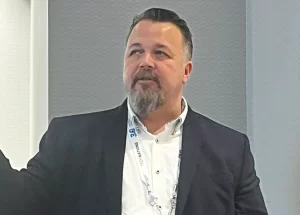Importance of fire safety by-laws discussed at First Nations conference in Niagara Falls

By Sam Laskaris
NIAGARA FALLS – Jeremy Parkin wears a lot of different hats.
For starters, he’s the director of emergency services for the Chippewas of Rama First Nation. Parkin is also the vice-president of the Ontario Association of Fire Chiefs, and the president of the National Indigenous Fire Safety Council.
Parkin was a speaker for a breakout session at the recent Ontario First Nations Technical Services Corporation (OFNTSC) conference, TechNations 2025 – Empowering Future Generations: 30 Years of Service and Innovation. The two-day event, which concluded on May 13, was held at Sheraton Fallsview in Niagara Falls, and marked the 30th year of the OFNTSC conference.
Parkin’s session at the conference was titled By-laws: Fire Safety Through Governance. During his presentation, Parkin talked about how having a solid governance system in place helps communities develop effective fire safety programs.
“We’re just management,” Parkin said of fire departments. “But if we have good infrastructure, we have good homes, we have good education, healthy communities, and we have water systems, all of these things build up your fire safety.”
Parkin also talked about why fire bylaws are important, the need for them, and why they are deemed positive.
“It’s kind of the nerdy thing in public safety,” he said. “But they’re quite important.”
Parkin provided details on what communities do before and after establishing their fire bylaws.
For starters, communities should do their Community Risk Assessments (CRA), which are mandatory for Ontario municipalities. These assessments, which lead to the Community Risk Reduction Plan, include determining hazards in the community, as well as the risks and risk levels and then providing treatment options. Bylaws are then adopted, then programs are launched on issues including smoke alarms and inspections.
Parkin also provided an interesting statistic. Of all the calls that fire departments receive, only about five per cent of them actually include a fire.
“That is the North American average for fire calls for fire departments,” he said. “That’s about all that they do – five per cent. The other per cent is all the other stuff.”
The other stuff includes medical calls, rescue calls, and alarm calls.
Parkin added that the seriousness of actual fire calls varies greatly.
“It could be a fully reaching house fire, could be a pot on the stove, could be burned toast and the chimney flue wasn’t opened and the house filled with smoke,” he said.
Parkin also provided some other interesting information.
“How many times of the five per cent of calls do they open a nozzle to spray water and put it out?” he asked of firefighting calls. “It’s far, far less than that.”
Parkin also said that through education, fire departments work towards limiting the amount of calls they have to respond to.
“From the community safety perspective, we have to be better, though,” he said. “We have to eliminate the calls. That’s the old quote, it’s the unmeasurable standard of how many calls we didn’t go to because our prevention efforts work, because our public education efforts work.”
Parkin also said it’s vital to keep new elected members of government informed.
“You should present your by-laws and your CRA to them so they understand what it is you’re doing,” he said.


